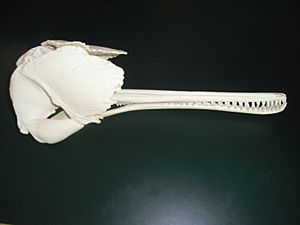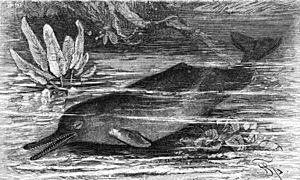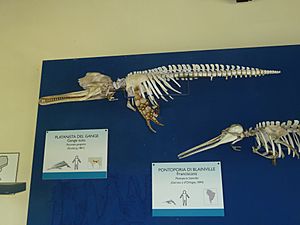South Asian river dolphin facts for kids
Quick facts for kids South Asian river dolphin |
|
|---|---|
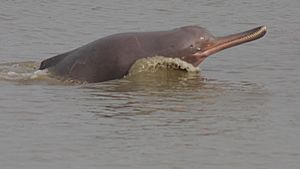 |
|
| Ganges river dolphin leaping out of the water | |
 |
|
| Size compared to an average human | |
| Conservation status | |
| Scientific classification | |
| Genus: |
Platanista
|
| Species: |
gangetica
|
| Subspecies | |
|
Platanista gangetica gangetica |
|
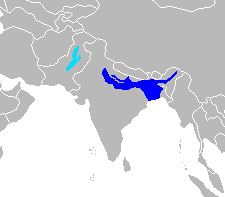 |
|
| Ranges of the Ganges river dolphin and of the Indus river dolphin | |
The South Asian river dolphin (Platanista gangetica) is a special type of river dolphin that lives in freshwater. You can find them in the Indian Subcontinent. Sadly, they are an endangered animal, which means there aren't many left.
There are two main groups, or subspecies, of this dolphin:
- The Ganges river dolphin (P. g. gangetica)
- The Indus river dolphin (P. g. minor)
The Ganges river dolphin mostly lives in the Ganges and Brahmaputra Rivers. These rivers flow through India, Bangladesh, and Nepal. The Indus river dolphin now only lives in the main part of the Indus River in Pakistan.
For a while, from the 1970s to 1998, people thought these two groups were different species. But in 1998, scientists decided they were actually two subspecies of the same animal. The Ganges river dolphin is very important to India; it's their National Aquatic Animal. It's also the official animal of the city of Guwahati. The Indus river dolphin is the National Mammal of Pakistan.
Contents
All About South Asian River Dolphins
These dolphins have a long, pointy nose, which is common for river dolphins. You can see their teeth even when their mouth is closed. Young dolphins have thin, curved teeth. But as they get older, their teeth change and become flat, square-shaped disks. The end of their nose gets thicker.
These dolphins use echolocation to find their way around and hunt for food. This is like using sound waves to "see" their surroundings. They are unique among dolphins because they often swim on their sides! Their body is brownish and a bit chunky in the middle. Instead of a tall dorsal fin, they only have a small, triangular bump on their back.
Their flippers and tail are thin but large compared to their body size. Males are usually about 2 to 2.2 meters long. Females are bigger, growing to about 2.4 to 2.6 meters. The oldest dolphin found was 28 years old and almost 2 meters long. Females grow larger than males, especially their noses, which keep growing even after the males' noses stop.
Dolphin Life
Life Cycle
Baby dolphins can be born any time of year. However, more births seem to happen between December and January, and again from March to May. A mother dolphin carries her baby for about 9 to 10 months before it's born. Young dolphins drink their mother's milk for about a year. They become old enough to have their own babies when they are about 10 years old.
During the rainy season, called the monsoon, these dolphins often move into smaller rivers that flow into the main river systems. Sometimes, you might see them with their noses sticking out of the water. They might even "breach," which means jumping partly or completely out of the water before landing on their sides!
What They Eat
South Asian river dolphins rely on echolocation to find their food. This is because they can't see very well. Their long nose helps them find prey that might be hidden or hard to spot. They grab their food with their jaws and swallow it whole. Their teeth are more for holding food than for chewing it.
These dolphins eat different kinds of shrimp and fish, like carp and catfish. The Ganges subspecies might even eat birds and turtles sometimes. You usually see these dolphins alone or in small, loose groups. They don't form large, tightly knit groups like some other dolphins.
How They See
These dolphins have eyes, but they don't have a clear lens like human eyes. This means they can't form clear images. They are basically blind, but their eyes can still sense light. The part of their eye that senses light is packed with special cells. They also have a very small optic nerve. Even without a clear lens, their eyes can still help them know if there's light around.
Their skin around the eye is very dark, stopping light from getting in, except through a tiny hole. This hole can sense light and might even tell them where the light is coming from. However, the rivers where they live are often very muddy or have low light. This makes the little vision they have not very useful.
How They Communicate
The Ganges river dolphin is very good at using echolocation to avoid things. They do this in their muddy river homes and even in clear water when they are in captivity. This shows they use sound to navigate and find food very well.
We don't know much about how they use sounds to talk to each other. They can make whistling sounds, but they don't do it often. This suggests that whistling might just be a random sound, not a way to communicate. Most of the time, Ganges river dolphins make echolocation sounds like clicks, bursts, and twitters. These sounds are similar to those made by the Amazon river dolphin. Both species often make sounds below 15 kHz, and their highest sounds are thought to be between 15 and 60 kHz.
Scientists can also use echolocation sounds to count how many dolphins are in a population. This method is still being developed and isn't used widely yet because it can be expensive and needs special skills.
Where They Live
South Asian river dolphins live in the freshwater river systems of Nepal, India, Bangladesh, and Pakistan. They like to be in water where there's lots of food and the current isn't too strong. They move with the seasons. When it's colder and water levels are low, they swim downstream. When it's warmer and water levels are high, they swim upstream.
The Ganges subspecies (P. g. gangetica) lives in the Ganges-Brahmaputra-Meghna and Karnaphuli-Sangu river systems in Bangladesh and India. They are also found in the Sapta Koshi and Karnali Rivers in Nepal. There might be a small group in the Ghaghara River, but this needs to be checked.
Since they are mammals, Ganges river dolphins can't breathe underwater. They have to come to the surface every 30 to 120 seconds to breathe. Because of the sound they make when they breathe, people often call them 'Susu'. These dolphins prefer deep pools, calm areas where rivers meet, and places near sharp bends in the river. They also like areas upstream and downstream of islands in the middle of the river.
The Indus subspecies (P. g. minor) now only lives in a 1,000 km stretch of the Indus River. They also live in some connecting channels between two dams called the Jinnah and Kotri barrages. In the past, they lived along 3,400 km of the Indus River and its smaller rivers. Their living area has shrunk by about 80% since 1870.
It's a mystery how these dolphins got into different river systems that aren't connected by the sea. It's unlikely they swam through the ocean because the river mouths are very far apart. One idea is that some rivers in northern India, like the Sutlej and Yamuna, changed their paths a long, long time ago. When the rivers changed, the dolphins stayed with them.



